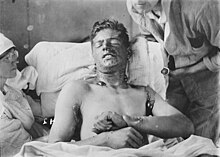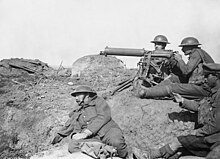See also: Technology during World War I and Weapons of World War I
Ground warfare
World War I began as a clash of 20th-century technology and 19th-century tactics, with the inevitably large ensuing casualties. By the end of 1917, however, the major armies, now numbering millions of men, had modernised and were making use of telephone, wireless communication,[235] armoured cars, tanks,[236] and aircraft. Infantry formations were reorganised, so that 100-man companies were no longer the main unit of manoeuvre; instead, squads of 10 or so men, under the command of a junior NCO, were favoured.
Artillery also underwent a revolution. In 1914, cannons were positioned in the front line and fired directly at their targets. By 1917, indirect fire with guns (as well as mortars and even machine guns) was commonplace, using new techniques for spotting and ranging, notably aircraft and the often overlooked field telephone.[237] Counter-battery missions became commonplace, also, and sound detection was used to locate enemy batteries.
Germany was far ahead of the Allies in utilising heavy indirect fire. The German Army employed 150 mm (6 in) and 210 mm (8 in) howitzers in 1914, when typical French and British guns were only 75 mm (3 in) and 105 mm (4 in). The British had a 6 inch (152 mm) howitzer, but it was so heavy it had to be hauled to the field in pieces and assembled. The Germans also fielded Austrian 305 mm (12 in) and 420 mm (17 in) guns and, even at the beginning of the war, had inventories of various calibers of Minenwerfer, which were ideally suited for trench warfare.[238]
Much of the combat involved trench warfare, in which hundreds often died for each yard gained. Many of the deadliest battles in history occurred during World War I. Such battles include Ypres, the Marne, Cambrai, the Somme, Verdun, andGallipoli. The Germans employed the Haber process of nitrogen fixation to provide their forces with a constant supply of gunpowder despite the British naval blockade.[239] Artillery was responsible for the largest number of casualties[240] and consumed vast quantities of explosives. The large number of head wounds caused by exploding shells and fragmentationforced the combatant nations to develop the modern steel helmet, led by the French, who introduced the Adrian helmet in 1915. It was quickly followed by the Brodie helmet, worn by British Imperial and US troops, and in 1916 by the distinctive German Stahlhelm, a design, with improvements, still in use today.
The widespread use of chemical warfare was a distinguishing feature of the conflict. Gases used included chlorine, mustard gas and phosgene. Few war casualties were caused by gas,[242] as effective countermeasures to gas attacks were quickly created, such as gas masks. The use of chemical warfare and small-scale strategic bombing were both outlawed by theHague Conventions of 1899 and 1907, and both proved to be of limited effectiveness,[243] though they captured the public imagination.[244]
The most powerful land-based weapons were railway guns, manufactured by the Krupp works, weighing hundreds of tons apiece. These were nicknamed Big Berthas, even though the namesake was not a railway gun. Germany developed theParis Gun, able to bombard Paris from over 100 kilometres (62 mi), though shells were relatively light at 94 kilograms (210 lb).
Trenches, machine guns, air reconnaissance, barbed wire, and modern artillery with fragmentation shells helped bring the battle lines of World War I to a stalemate. The British and the French sought a solution with the creation of the tank andmechanised warfare. The British first tanks were used during the Battle of the Somme on 15 September 1916. Mechanical reliability was an issue, but the experiment proved its worth. Within a year, the British were fielding tanks by the hundreds, and they showed their potential during the Battle of Cambrai in November 1917, by breaking the Hindenburg Line, while combined arms teams captured 8,000 enemy soldiers and 100 guns. Meanwhile, the French introduced the first tanks with a rotating turret, the Renault FT, which became a decisive tool of the victory. The conflict also saw the introduction of light automatic weapons and submachine guns, such as the Lewis Gun, the Browning automatic rifle, and the Bergmann MP18.
Another new weapon, the flamethrower, was first used by the German army and later adopted by other forces. Although not of high tactical value, the flamethrower was a powerful, demoralising weapon that caused terror on the battlefield.
Trench railways evolved to supply the enormous quantities of food, water, and ammunition required to support large numbers of soldiers in areas where conventional transportation systems had been destroyed. Internal combustion engines and improved traction systems for automobiles and trucks/lorries eventually rendered trench railways obsolete.
Germany deployed U-boats (submarines) after the war began. Alternating between restricted and unrestricted submarine warfare in the Atlantic, the Kaiserliche Marine employed them to deprive the British Isles of vital supplies. The deaths of British merchant sailors and the seeming invulnerability of U-boats led to the development of depth charges (1916),hydrophones (passive sonar, 1917), blimps, hunter-killer submarines (HMS R-1, 1917), forward-throwing anti-submarine weapons, and dipping hydrophones (the latter two both abandoned in 1918).[83] To extend their operations, the Germans proposed supply submarines (1916). Most of these would be forgotten in the interwar period until World War II revived the need.
Aviation
- Main article: Aviation in World War I
Fixed-wing aircraft were first used militarily by the Italians in Libya on 23 October 1911 during the Italo-Turkish War for reconnaissance, soon followed by the dropping of grenades and aerial photography the next year. By 1914, their military utility was obvious. They were initially used for reconnaissance and ground attack. To shoot down enemy planes, anti-aircraft guns and fighter aircraft were developed.Strategic bombers were created, principally by the Germans and British, though the former used Zeppelins as well.[246] Towards the end of the conflict, aircraft carrierswere used for the first time, with HMS Furious launching Sopwith Camels in a raid to destroy the Zeppelin hangars at Tondern in 1918.[247]
Manned observation balloons, floating high above the trenches, were used as stationary reconnaissance platforms, reporting enemy movements and directing artillery. Balloons commonly had a crew of two, equipped with parachutes,[248] so that if there was an enemy air attack the crew could parachute to safety. At the time, parachutes were too heavy to be used by pilots of aircraft (with their marginal power output), and smaller versions were not developed until the end of the war; they were also opposed by the British leadership, who feared they might promote cowardice.[249]
Recognised for their value as observation platforms, balloons were important targets for enemy aircraft. To defend them against air attack, they were heavily protected by antiaircraft guns and patrolled by friendly aircraft; to attack them, unusual weapons such as air-to-air rockets were even tried. Thus, the reconnaissance value of blimps and balloons contributed to the development of air-to-air combat between all types of aircraft, and to the trench stalemate, because it was impossible to move large numbers of troops undetected. The Germans conducted air raids on England during 1915 and 1916 with airships, hoping to damage British morale and cause aircraft to be diverted from the front lines, and indeed the resulting panic led to the diversion of several squadrons of fighters from France.[246][249]




ليست هناك تعليقات:
إرسال تعليق